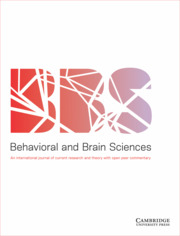Crossref Citations
This article has been cited by the following publications. This list is generated based on data provided by Crossref.
Wahn, Basil
and
Wiese, Eva
2025.
Humans take the visuospatial perspective of robots and objects that imply social presence.
Acta Psychologica,
Vol. 254,
Issue. ,
p.
104801.



Target article
Social robots as depictions of social agents
Related commentaries (29)
A more ecological perspective on human–robot interactions
A neurocognitive view on the depiction of social robots
Anthropomorphism, not depiction, explains interaction with social robots
Autonomous social robots are real in the mind's eye of many
Binding paradox in artificial social realities
Children's interactions with virtual assistants: Moving beyond depictions of social agents
Cues trigger depiction schemas for robots, as they do for human identities
Dancing robots: Social interactions are performed, not depicted
Depiction as possible phase in the dynamics of sociomorphing
Fictional emotions and emotional reactions to social robots as depictions of social agents
How cultural framing can bias our beliefs about robots and artificial intelligence
How deep is AI's love? Understanding relational AI
How puzzling is the social artifact puzzle?
Interacting with characters redux
Meta-cognition about social robots could be difficult, making self-reports about some cognitive processes less useful
Of children and social robots
On the potentials of interaction breakdowns for HRI
People treat social robots as real social agents
Social robots and the intentional stance
Social robots as social learning partners: Exploring children's early understanding and learning from social robots
Taking a strong interactional stance
The Dorian Gray Refutation
The now and future of social robots as depictions
The second-order problem of other minds
Trait attribution explains human–robot interactions
Unpredictable robots elicit responsibility attributions
Virtual and real: Symbolic and natural experiences with social robots
When Pinocchio becomes a real boy: Capability and felicity in AI and interactive depictions
“Who's there?”: Depicting identity in interaction
Author response
On depicting social agents